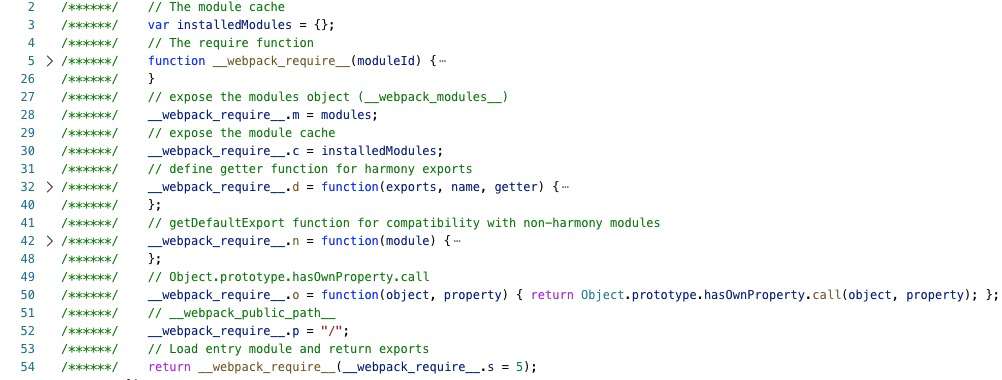webpack源码-打包资源输出到本地
webpack收集完依赖是怎么打包资源的呢?
入口compiler.js:
this.applyPluginsParallel("make", compilation, err => {
if(err) return callback(err);
compilation.finish();
compilation.seal(callback);
});
执行seal方法,createChunkAssets方法(compilation.js)
在createChunkAssets方法的时候做如下判断:
if(chunk.hasRuntime()) {
source = this.mainTemplate.render(this.hash, chunk, this.moduleTemplate, this.dependencyTemplates);
} else {
source = this.chunkTemplate.render(chunk, this.moduleTemplate, this.dependencyTemplates);
}
根据是否是entrypoints,进行资源打包(chunk.js)。
上面的mainTemplate.render方法:
render(hash, chunk, moduleTemplate, dependencyTemplates) {
const buf = [];
buf.push(this.applyPluginsWaterfall("bootstrap", "", chunk, hash, moduleTemplate, dependencyTemplates));
buf.push(this.applyPluginsWaterfall("local-vars", "", chunk, hash));
buf.push("");
buf.push("// The require function");
buf.push(`function ${this.requireFn}(moduleId) {`);
buf.push(this.indent(this.applyPluginsWaterfall("require", "", chunk, hash)));
buf.push("}");
buf.push("");
buf.push(this.asString(this.applyPluginsWaterfall("require-extensions", "", chunk, hash)));
buf.push("");
buf.push(this.asString(this.applyPluginsWaterfall("startup", "", chunk, hash)));
let source = this.applyPluginsWaterfall("render", new OriginalSource(this.prefix(buf, " \t") + "\n", `webpack/bootstrap ${hash}`), chunk, hash, moduleTemplate, dependencyTemplates);
if(chunk.hasEntryModule()) {
source = this.applyPluginsWaterfall("render-with-entry", source, chunk, hash);
}
if(!source) throw new Error("Compiler error: MainTemplate plugin 'render' should return something");
chunk.rendered = true;
return new ConcatSource(source, ";");
}
buf中保存了webpackBootstrap中的主体代码:
 

render钩子(MainTemplate.js)
const source = new ConcatSource();
source.add("/******/ (function(modules) { // webpackBootstrap\n"); // 添加头部包裹体
source.add(new PrefixSource("/******/", bootstrapSource)); // 添加bootstrap主体
source.add("/******/ })\n"); // 结束
source.add("/***************************** *******************************************/\n");
source.add("/******/ (");
const modules = this.renderChunkModules(chunk, moduleTemplate, dependencyTemplates, "/******/ "); // 返回一个concatSource的一个实例,包含了需要打包的所有内容
source.add(this.applyPluginsWaterfall("modules", modules, chunk, hash, moduleTemplate, dependencyTemplates));
source.add(")");
return source; // 返回一个concatSource实例
主要做了两件事:
1.生成webpackBootstrap中的主体代码
2.添加所有的代码到concatSource中
最后,执行compiler.run的回调函数 onCompiled(null, compilation)
执行 emitAssets方法
this.outputFileSystem.mkdirp(this.outputFileSystem.join(outputPath, dir), writeOut);// 创建dist目录
const targetPath = this.outputFileSystem.join(outputPath, targetFile);
const source = compilation.assets[file]; // createChunkAssets中有这样的处理this.assets[file] = source;
......
let content = source.source();
if(!Buffer.isBuffer(content)) {
content = new Buffer(content, "utf8");
}
......
this.outputFileSystem.writeFile(targetPath, content, callback);// 输出到本地文件系统
至此打包资源,然后就基本结束了。
webpack源码-打包资源输出到本地的更多相关文章
- RPMBUILD源码打包资源汇总(转)
http://mattshma.github.io/2015/11/04/rpm%E6%89%93%E5%8C%85/ http://400053.blog.51cto.com/390053/7210 ...
- 从Webpack源码探究打包流程,萌新也能看懂~
简介 上一篇讲述了如何理解tapable这个钩子机制,因为这个是webpack程序的灵魂.虽然钩子机制很灵活,而然却变成了我们读懂webpack道路上的阻碍.每当webpack运行起来的时候,我的心态 ...
- .3-浅析webpack源码之预编译总览
写在前面: 本来一开始想沿用之前vue源码的标题:webpack源码之***,但是这个工具比较巨大,所以为防止有人觉得我装逼跑来喷我(或者随时鸽),加上浅析二字,以示怂. 既然是浅析,那么案例就不必太 ...
- .30-浅析webpack源码之doResolve事件流(1)
这里所有的插件都对应着一个小功能,画个图整理下目前流程: 上节是从ParsePlugin中出来,对'./input.js'入口文件的路径做了处理,返回如下: ParsePlugin.prototype ...
- .17-浅析webpack源码之compile流程-入口函数run
本节流程如图: 现在正式进入打包流程,起步方法为run: Compiler.prototype.run = (callback) => { const startTime = Date.now( ...
- .30-浅析webpack源码之doResolve事件流(2)
这里所有的插件都对应着一个小功能,画个图整理下目前流程: 上节是从ParsePlugin中出来,对'./input.js'入口文件的路径做了处理,返回如下: ParsePlugin.prototype ...
- Spring源码分析——资源访问利器Resource之实现类分析
今天来分析Spring的资源接口Resource的各个实现类.关于它的接口和抽象类,参见上一篇博文——Spring源码分析——资源访问利器Resource之接口和抽象类分析 一.文件系统资源 File ...
- maven源码打包
1.打包时附加外部Jar包 <!--编译+外部 Jar打包--> <plugin> <artifactId>maven-co ...
- 使用 maven 自动将源码打包并发布
1.maven-source-plugin 访问地址 在 pom.xml 中添加 下面的 内容,可以 使用 maven 生成 jar 的同时 生成 sources 包 <plugin> & ...
随机推荐
- 'ipconfig' 不是内部或外部命令,也不是可运行的程序 或批处理文件
今天在学习的时候需要找本地ip地址,可是在命令行窗口却显示 百度之后发现原来是环境变量没配置的问题(其实之前是ok的,但应该是anconda安装的时候点了那个一键设置环境变量搞得本地的path里的数据 ...
- centos 6.5 nat方式上网络设置
1 前提虚拟机采用nat的方式和主机进行通信,这个时候再电脑上会模拟一个vmnet8网卡,如果是host-only对应的是vmnet1,配置一样 vmnet8的虚拟网卡,虚拟机通过vmnet8和主机之 ...
- 阿里巴巴开源canal 工具数据同步异常CanalParseException:parse row data failed,column size is not match for table......
一.异常现象截图 二.解决方式: 1.背景 早期的canal版本(<=1.0.24),在处理表结构的DDL变更时采用了一种简单的策略,在内存里维护了一个当前数据库内表结构的镜像(通过desc ...
- WTL中GDI+支持资源文件加载
WTL中GDI+支持资源文件加载 分类: WTL WTL gdi+ gdi+2013-04-22 17:16 78人阅读 评论(0) 收藏 举报 WTLGDI+c++ 今天遇到一个小问题困扰了.就是G ...
- HttPclient 以post方式发送json
使用HttpClient 以POST的形式发送json字符串 步骤: 1.url .parameters 2.创建httpClient对象 3.创建HttpPost对象 4.为post对象设置参数 5 ...
- Python并发编程理论篇
Python并发编程理论篇 前言 其实关于Python的并发编程是比较难写的一章,因为涉及到的知识很复杂并且理论偏多,所以在这里我尽量的用一些非常简明的语言来尽可能的将它描述清楚,在学习之前首先要记住 ...
- 初探numpy——广播和数组操作函数
numpy广播(Broadcast) 若数组a,b形状相同,即a.shape==b.shape,那么a+b,a*b的结果就是对应数位的运算 import numpy as np a=np.array( ...
- 每日一题 - 剑指 Offer 49. 丑数
题目信息 时间: 2019-07-03 题目链接:Leetcode tag:动态规划 小根堆 难易程度:中等 题目描述: 我们把只包含质因子 2.3 和 5 的数称作丑数(Ugly Number).求 ...
- css定位方式有哪几种?
复杂的网页布局都是通过各种网页元素灵活定位实现的,网页中的各种元素定位都有自己的特点.下面我们来看一下css的几种定位方式. float定位(即浮动定位): 这种定位方式很简单,只需规定一个浮动的方向 ...
- 哎,老了之display-box
哎,不想吐槽自己了,表示已远远落后,从今天起开始恶补吧,来一个实例 <html> <head> <meta name="generator" cont ...
